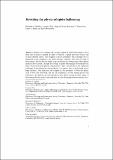Revisiting the Physics of Spider Ballooning
Author(s)
Sheldon, Kimberly S.; Zhao, Longhua; Chuang, Angela; Panayotova, Iordanka N.; Miller, Laura A.; Bourouiba, Lydia; ... Show more Show less
DownloadAccepted version (426.7Kb)
Open Access Policy
Open Access Policy
Creative Commons Attribution-Noncommercial-Share Alike
Terms of use
Metadata
Show full item recordAbstract
Spiders use a unique type of aerial dispersal called “ballooning” to move from one location to another. In order to balloon, a spider must first release one or more flexible, elastic, silk draglines from its spinnerets. Once enough force is generated on the dragline(s), the spider becomes airborne. This “take-off” stage of ballooning is followed by the “flight” stage and finally the “settling” stage when spiders land in a new location. Though the ecology of spider ballooning is well understood, little is known about the physical mechanisms. This is in part due to the significant challenge of describing the relevant physics for spiders that are ballooning across large distances. One difficulty, for example, is that properties of both the spider, such as body size and shape, and the silk dragline(s) can vary among species and individuals. In addition, the relevant physics may differ among the three stages of ballooning. Finally, models must take into account the interaction between the flexible dragline and air, and resolving this multi–scale, fluid–structure interaction can be particularly difficult. Here, we review the literature on spider ballooning, including the relevant physics, meteorological conditions that favor ballooning, and previous mechanical models used to describe ballooning. We then highlight challenges and open questions relevant to future modeling of spider ballooning.
Date issued
2017-08Department
Massachusetts Institute of Technology. Fluid Dynamics of Disease Transmission LaboratoryJournal
Women in Mathematical Biology
Publisher
Springer International Publishing
Citation
Sheldon, K.S. et al. "Revisiting the Physics of Spider Ballooning." Women in Mathematical Biology 8 (August 2017): 163-178 © 2017 The Author(s) and the Association for Women in Mathematics
Version: Author's final manuscript
ISBN
9783319603025
9783319603049
ISSN
2364-5733
2364-5741